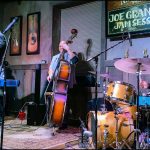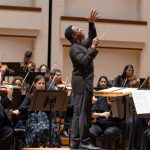June 10, 2021
Robert Spano, music director / conductor
Jessica Rivera, soprano
Samuel BARBER: Knoxville: Summer of 1915 Op. 24
Gustav MAHLER: Symphony No. 4 in G major
MARK GRESHAM | 11 JUN 2021
On Thursday evening a significant era drew to a close for the Atlanta Symphony Orchestra with its final concert with Robert Spano as music director. Only the fourth music director in the ASO’s 76-year history, Spano will remain on board as an adviser-conductor for the 2021-22 season as the search for his successor continues, and will take up the title of ASO music director laureate as he also takes on the mantle of music director for the Fort Worth Symphony Orchestra.
It is fitting that the COVID-19 pandemic has eased up enough for over 70 musicians to participate in this grand finale, over twice as many persons as was allowed onstage at the beginning of this unusual but necessarily virtual season for the orchestra, making possible the inclusion of Gustav Mahler’s Symphony No. 4 on the program without cutting it down in any way.
Spano’s close musical colleague, soprano Jessica Rivera, was vocal soloist in both the Fourth Symphony and Samuel Barber’s Knoxville: Summer of 1915, a setting of the poem by James Agee. The pairing of the two works was a brilliant programming stroke by Spano.
Naturally, it was the much shorter of the two works, Barber’s 15-minute Knoxville: Summer of 1915, that opened the program. Composed in 1947, the text is drawn from James Agee’s short 1938 prose piece of the same name, in which the narrating persona is that of a male child. It was written for and is typically sung by a soprano, although it has also been sung at times by a tenor.
The opening line elicits dreamy nostalgia for an idyllic America that was once quite real, but is now long past, through early childhood memories of idle summer evenings in Knoxville, Tennessee. It is a celebration of the ordinary, as felt by a child surrounded by a loving family, evoked by its opening lines:
With Agee’s final lines, as night falls, we’re left with a sense of the child’s awe and wonder about his self and place in this world, and a quiet awareness and acceptance of human mortality:

Soprano Jessica Rivera (ASO)
The sense of a child’s wonderment and depth of meaning was delivered beautifully by soprano Jessica Rivera, both in her exquisite singing and her facial expressions – expressively subtle, something that the video camera by its nature tends to amplify in closeups, but it came out just right, not overdone.
The music by Barber – who was himself a capable enough baritone to sing a public recital – is admirably well-suited to the text. For me, Barber’s music often spells out “American” even more than that of Copland; especially so in this piece. This was a most gratifying, skilled and emotionally moving performance.

Robert Spano leads the ASO in his final concert as the orchestra’s music director. (ASO)
Gustav Mahler wrote his Symphony No. 4 in 1899 and 1900, although it incorporates a song he wrote written in 1892, “Das himmlische Leben” (“The Heavenly life”), in its fourth and final movement. Like Agee’s poem, the text, presents its subject from a child’s perspective. In this case, a child’s vision of Heaven. As with Barber’s Knoxville, it is sung by a soprano. It is drawn from the German folk-poem collection Des Knaben Wunderhorn, where the poem is entitled “Der Himmel hängt voll Geigen” (literally, “the sky hangs full of violins” an idiomatic expression that’s similar in meaning to “not a cloud in the sky”). The first verse translates:
That’s why we avoid the earthly.
No worldly turmoil
Do you hear in heaven!
Everything lives in the most gentle peace.
We lead an Angelic life,
nevertheless still quite merry;
We dance and jump,
We hop and sing,
Saint Peter in Heaven is watching.
The music of the fourth movement, which is the only one with a vocal part, is prefigured in various means in the first three. For example, the first three bars of the first movement, with their signature sleigh bells, are not only heard again at the start of that movement’s recapitulation recapitulation, but also foreshadow their use in the fourth movement in varied instrumentations at rehearsal numbers 3, 7 and 11. These kinds of forward-looking treatments of themes not only help unify the entire Symphony, but point to how the fourth movement is the conceptual foundation of the entire. Everything that has come before leads to it.

The Atlanta Symphony Orchestra performing Mahler’s Symphony No. 4, with over twice as many musicians onstage as the early concerts of the 2020-21 virtual season. (ASO)
That brings us back to Barber’s Knoxville as a brilliant prologue to Mahler’s Fourth Symphony. Agee’s prose text and the folk-poetry of “Das himmlische Leben” form a pair of bookends to the concert as a whole, giving it a rather convincing arch from start to finish, feeling all of a single gesture. At almost an hour long, Mahler’s Fourth is four times as long as Barber’s Knoxville. The Symphony’s final movement is around 10 minutes long, which seems to make for a good balance between the program’s two vocal flanks.
I was particularly impressed by the clarity of the performance by the ASO musicians and Spano, which felt lean, lithe and unweighted yet richly expressive and communicative. Mahler’s Fourth ends quietly, closing the concert with an air of peaceful bliss. It was not a bombastic send-off for Spano; rather, and more importantly, a farewell of overwhelming beauty, grace and humanity. ■
RECENT POSTS







.png)